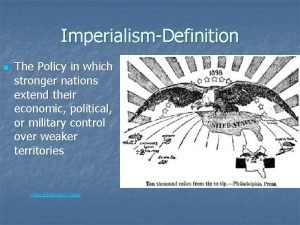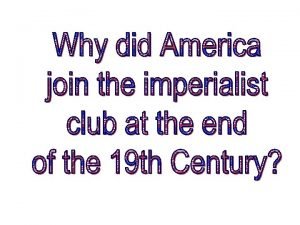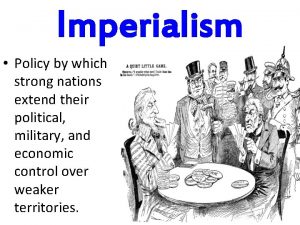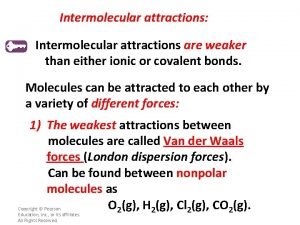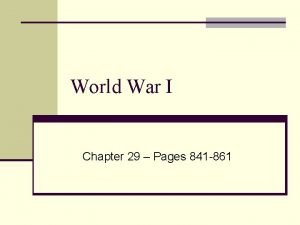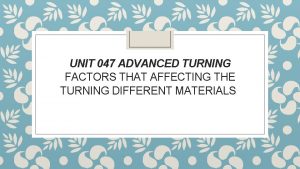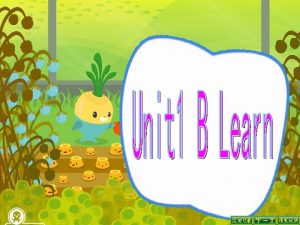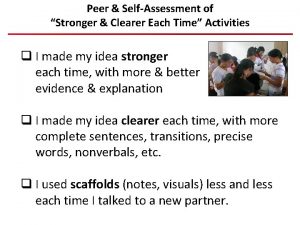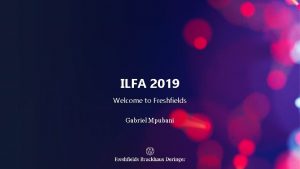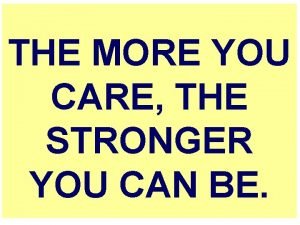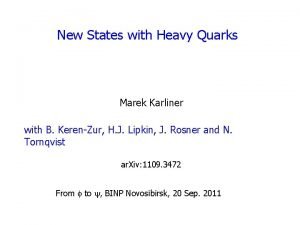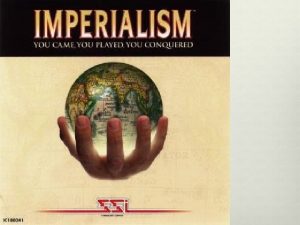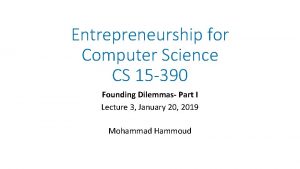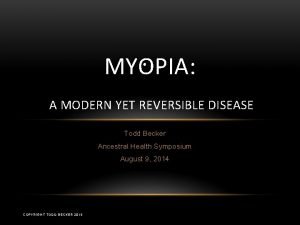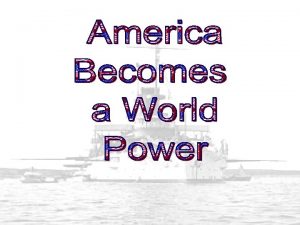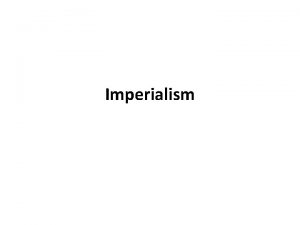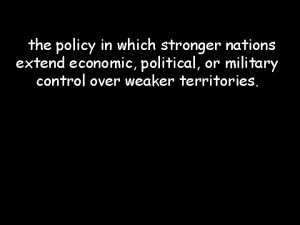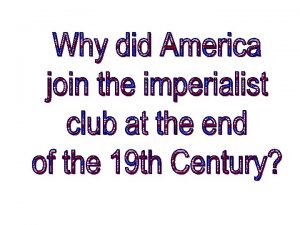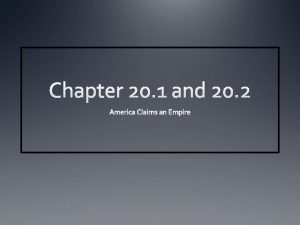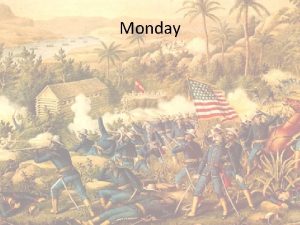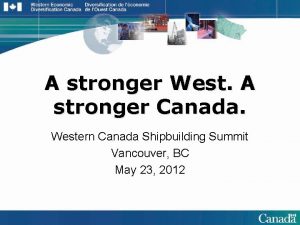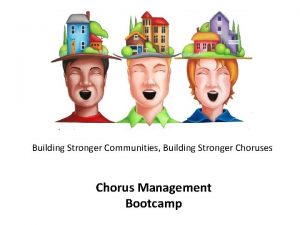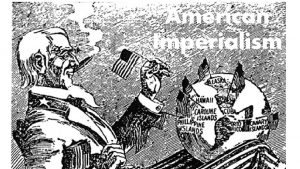ImperialismDefinition n The Policy in which stronger nations



















- Slides: 19

Imperialism-Definition n The Policy in which stronger nations extend their economic, political, or military control over weaker territories View Expansion Video

*3 Reasons for American Imperialism n n n 1. Economic competition for raw materials and markets for its manufactured goods. 2. Political and Military competition, based on the need for a powerful new navy 3. A belief in racial superiority and mission to spread Christianity and civilization to the world View American Expansionism around 1900

Anti-Imperialism n Not everyone agreed U. S. should expand n n Some felt it was morally wrong Some felt it cost too much money

America Expands-Alaska n *“Seward’s Folly”-the purchase of Alaska n n *1867, US bought Alaska from Russia for $7. 2 million (2 cents an acre) Thomas Nast cartoon of Seward People thought Alaska was frozen wasteland a huge mistake William Seward

America Expands-Hawaii n n Annex-to acquire/take over 1898 -United States/ President Mc. Kinley annexed Hawaii n n Overthrow of Queen Lil, and Native Hawaiians Wanted access to China and East Last Queen of Hawaii, Lil Sanford B. Dole

The Spanish-American War 1898 n n Cuba was fighting Spain for Independence Jose Marti`-Cuban leader *Spain put 300, 000 civilians in concentration camps *American newspapers began writing exaggerated claims of Spanish brutality towards Cubans that became known as Yellow Journalism exaggerated news to lure new readers Jose Marti “Yellow Kid” Cartoon Newspaper drawing about Spanish officials strip searching U. S. woman

Yellow Journalism n n Two New York Journalists race to sell the most papers Joseph Pulitzer and William Randolph Hearst publish lies about the war to sell the most papers Joseph Pulitzer William Randolph Hearst

The Spanish-American War 1898 n *3 reasons U. S. enters War n n n *1. yellow journalism *2. De. Lome Letter. Spanish ambassador claims Pres. Mc. Kinley is “weak” *3. The U. S. S. Maine mysteriously blows up in Havana and the U. S. blames Spain

*“The Splendid Little War” n n U. S. attacks Spanish fleet at Manila Bay in Philippines (Spanish territory) U. S. and Filipino forces quickly defeat Spanish

“The Splendid Little War” n War in Cuba n n n Fighting is somewhat fierce *Teddy Roosevelt leads a group of volunteers called The Rough Riders in the Battle of San Juan Hill in Cuba Rough Riders play only small part, but Roosevelt becomes famous San Juan Hill Rough Riders African-American Unit that fought along side Rough Riders

*Treaty of Paris 1898 n n Spain grants Cuba its Independence U. S. gets the Philippines, Puerto Rico, and Guam Platt Amendment allowed the U. S. to intervene in Cuba’s affairs, which U. S. did on multiple occasions. n Guantanamo Bay Cuba became a Protectorate of U. S.


This cartoon dates to 1898 shortly after the war 1. What symbols are used to represent the various nations involved in the unfolding drama of the birth of the American empire? 2. How does the portrayal of Cuba in this cartoon compare with the previous cartoon?

“Won’t you join the stars and be my forty-sixth? 1. What is the significance of Cuba being represented as white and attractive or voluptuous? 2. Explain the apparent intention of the artist in the context of 1901, when Spanish troops had left Cuba and the United States continued its military occupation of the island?

Philippine-American War n n Filipinos were outraged when U. S. did not grant independence War lasted for 3 years 1899 to 1902 n n n 20, 000 Filipinos died 4, 000 U. S. troops died Needed Philippines for easier access to China New York Journal –example of Yellow Journalism during Philippine-American War

America As World Power n Great White Fleet n n New all steel fleet of a dozen or so ships that TR sent around the world to show U. S. dominance Painted white

America As World Power n Panama Canal n n Built to connect Atlantic and Pacific Ocean Cutting travel time of U. S. ships by half Panama was province of Colombia, but TR helped Panama get its Independence to get Canal built Teddy Roosevelt got credit

Roosevelt and Latin America n *Gunboat Diplomacy n n *Use force to accomplish goals in world, especially Latin America *“Speak softly and carry a big stick; you will go far”-famous saying by Teddy

*Achievements During Imperialism n n n U. S. expanded access to foreign markets to ensure economic growth Built a modern Navy to protect its interest abroad Became an international police force to ensure domestic dominance in Latin America
 Imperialismdefinition
Imperialismdefinition The policy in which stronger nations
The policy in which stronger nations De lome letter definition
De lome letter definition Queen liliuokalani
Queen liliuokalani Covalent bond vs hydrogen bond which is stronger
Covalent bond vs hydrogen bond which is stronger Which acid is stronger hcl or hbr
Which acid is stronger hcl or hbr Which three nations belonged to the triple entente
Which three nations belonged to the triple entente Steel stronger than iron
Steel stronger than iron Taller and younger shorter and older
Taller and younger shorter and older Is uv getting stronger
Is uv getting stronger Jeff zwiers
Jeff zwiers Wish clause
Wish clause Bigger better stronger faster
Bigger better stronger faster The takeover of a country or territory by a stronger nation
The takeover of a country or territory by a stronger nation Shawn der kinderen
Shawn der kinderen The more you care the stronger you can be
The more you care the stronger you can be Marek karliner
Marek karliner Imperialism and industrialization
Imperialism and industrialization How get stronger year
How get stronger year Eaton heinemann
Eaton heinemann
